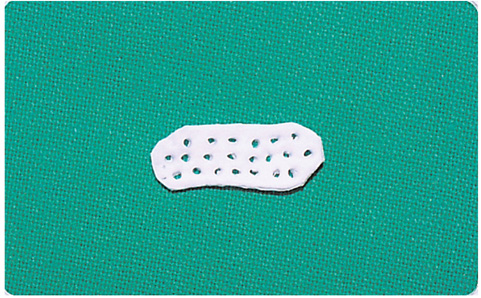Korean J Ophthalmol.
2005 Dec;19(4):247-251. 10.3341/kjo.2005.19.4.247.
Polytetrafluoroethylene as a Spacer Graft for the Correction of Lower Eyelid Retraction
- Affiliations
-
- 1Department of Ophthalmology, College of Medicine, University of Ulsan, Asan Medical Center, Seoul, Korea.
- 2Department of Ophthalmology, Seoul National University College of Medicine, Seoul, Korea. khwarg@snu.ac.kr
- 3Artificial Eye Center, Seoul National University Hospital Clinical Research Institute, Seoul, Korea.
- KMID: 754434
- DOI: http://doi.org/10.3341/kjo.2005.19.4.247
Abstract
- PURPOSE
To evaluate the efficacy of porous expanded polytetrafluoroethylene (e-PTFE, Goretex (R) ) containing large pores made with a 21-gauge needle as a graft for the correction of lower lid retraction. METHODS: e-PTFE grafts were implanted between the tarsus and lower lid retractor via a transconjunctival approach with/without amniotic membrane transplantation, or via a transcutaneous approach. Rabbits were examined and assessed for corneal and conjunctival complications and for e-PTFE graft status. Rabbits were sacrificed for a histological study at 8 weeks postoperatively. RESULTS: e-PTFE grafts were uniformly extruded 3 weeks postoperatively in eyelids operated on via the transconjunctival approach. However, rabbits operated on via the transcutaneous approach demonstrated e-PTFE graft retention; in addition, dense fibrovascular ingrowths into the large pores of e-PTFE were observed histologically. CONCLUSIONS: e-PTFE is a good substitute for other graft materials as a spacer in lower lid retraction operations, especially as an interpositional graft using a transcutaneous approach.
Keyword
MeSH Terms
Figure
Cited by 1 articles
-
Surgical Correction of Lid Retraction with a Silicone Sponge in Congenital Fibrosis of the Extraocular Muscles
Hwan Heo, Kyoung Chul Yoon, Yeoung-Geol Park, Sang Woo Park
Chonnam Med J. 2010;46(3):195-198. doi: 10.4068/cmj.2010.46.3.195.
Reference
-
1. Tanenbaum M, McCord CD Jr, Nunery WR. McCord CD, Tanenbaum M, Nunery WR, editors. Graves' Ophthalmopathy. Oculoplastic Surgery. 1995. 3rd ed. New York: Raven Press;chap. 14.2. Cohen MM, Lessell S. Retraction of the lower eyelid. Neurology. 1979. 29:386–389.3. Chang EL, Rubin PAD. Upper and lower eyelid retraction. Int Ophthalmol Clin. 2002. 42:45–59.4. Dryden RM, Soll DB. The use of scleral tranplantation in cicatrical entropion and eyelid retraction. Trans Am Acad Ophthalmol Otolaryngol. 1977. 83:669–676.5. Doxanas MT, Dryden RM. The use of sclera in the treatment of dysthyroid eyelid retraction. Ophthalmology. 1981. 88:887–894.6. Mourits MP, Koorneef L. Lid lengthening by sclera interposition for eyelid retraction in Graves' ophthalmopathy. Br J Ophthalmol. 1991. 75:344–347.7. Baylis HI, Perman KI, Fett DR, Sutcliffe RT. Autogenous auricular cartilage grafting for lower eyelid retraction. Ophthalmic Plast Reconstr Surg. 1985. 1:23–27.8. Wearne MJ, Sandy C, Rose GE, et al. Autogenous hard palate mucosa: the ideal lower eyelid spacer? Br J Ophthalmol. 2001. 85:1183–1187.9. Siegel RJ. Palatal grafts for eyelid reconstruction. Plast Reconstruct Surg. 1985. 76:411–416.10. Karesh JW, Fabrega MA, Rodrigues MM, Glaros DS. Polytetrafluoroethylene as an interpositional graft material for the correction of lower eyelid retraction. Ophthalmology. 1989. 96:419–423.11. Levin PS, Dutton JJ. Polytef (Polytetrafluoroethylene) alloplastic grafting as a substitute for mucous membrane. Arch Ophthalmol. 1990. 108:282–285.12. Karesh JW. Biomaterials in ophthalmic plastic and reconstructive surgery. Curr Opin Ophthalmol. 1998. 9:66–74.13. Wang J, Fan J, Nordstrom REA. Evaluation of lip augmentation with Gore-tex facial implant. Aesth Plast Surg. 1997. 21:433–436.14. Wilson AG, Plessas SJ, Gray T, Forster IW. Lymphadenopathy after Gore-tex anterior cruciate ligament reconstruction. Am J Sports Med. 1998. 26:133–135.15. Karesh JW, Fabrega MA, Rodrigues MM. Interpositional polytetrafluoroethylene grafts Conjunctival biocompatibility. Ophthalmic Plast Reconstr Surg. 1991. 7:278–283.16. Cas RD, Maus M, Bilyk J, et al. Gore-tex as an orbitalimplant material. Ophthal Plast Reconstr Surg. 1998. 14:425–431.17. Waller RR. Lower eyelid retraction: management. Ophthalmic Surg. 1978. 9:41–47.18. Holds JB, Anderson RL, Thiese SM. Lower eyelid retraction: a minimal incision surgical approach to retractor lysis. Ophthalmic Surg. 1990. 21:767–771.19. Karesh JW. Polytetrafluoroethylene as a graft material in ophthalmic plastic and reconstructive surgery: an experimental and clinical study. Ophthalmic Plast Reconstr Surg. 1987. 3:179–185.20. Fabrega MA, Glaros DS, Karesh JW. Biocompatibility of polytetrafluoroethylene grafts: in vitro and in vivo studies. ARVO Abstracts. Invest Ophthalmol Vis Sci. 1988. 29:S212.21. Hanel KC, McCabe C, Abbott WM, et al. Current PTFE grafts: a biomechanical, scanning electron, and light microscopic evaluation. Ann Surg. 1982. 195:456–463.22. Choo PH, Carter SR, Crawford JB, Seiff SR. Exposure of expanded polytetrafluoroethylene-wrapped hydroxyapatite orbital implant: A report of two patients. Ophthalmic Plast Reconstr Surg. 1998. 15:77–78.23. Kim JC, Tseng SCG. Transplantation of preserved human amniotic membrane for surface reconstruction in severely damaged rabbit corneas. Cornea. 1995. 14:473–484.24. Lee SH, Tseng SCG. Amniotic membrane transplantation for persistent epithelial defects with ulceration. Am J Ophthalmol. 1997. 123:303–312.25. Prabhasawat P, Barton K, Burkett G, Tseng SCG. Comparison of conjunctival autografts, amniotic membrane grafts, and primary closure for pterygium excision. Ophthalmology. 1997. 104:974–985.26. Tseng SCG, Prabhasawat P, Lee SH. Amniotic membrane transplantation for conjunctival surface reconstruction. Am J Ophthalmol. 1997. 124:765–774.27. Ti SE, Tow SLC, Chee SP. Amniotic membrane transplantation in entropion surgery. Ophthalmology. 2001. 108:1209–1217.28. Morton AD, Nelson C, Ikada Y, Elner VM. Porous polyethylene as a spacer graft in the treatment of lower eyelid retraction. Ophthalmic Plast Reconstr Surg. 2000. 16:146–155.
- Full Text Links
- Actions
-
Cited
- CITED
-
- Close
- Share
- Similar articles
-
- Acellular Dermal Allograft for the Correction of Eyelid Retraction
- Surgical Correction of Lid Retraction with a Silicone Sponge in Congenital Fibrosis of the Extraocular Muscles
- Treatment of Lower Eyelid Retraction
- Lower Blepharoplasty in Aged Persons
- Spacer Graft Combined with Canthal Sling in Paralytic Ectropion






